Tracheoesophageal fistula repair - series
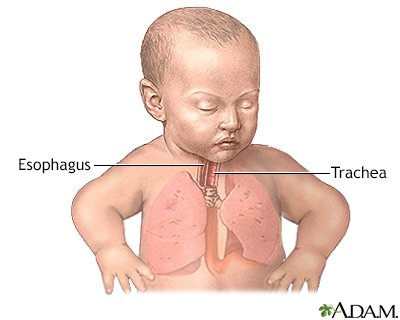
Normal anatomy
The trachea and esophagus run next to each other through the chest cavity. The esophagus connects to the stomach, and carries food and saliva to the stomach. The trachea connects to the lungs and carries air to the lungs.
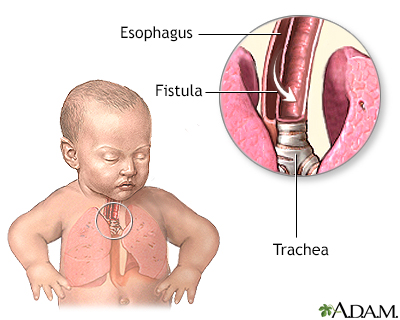
Indications
A tracheoesophageal fistula is a congenital anomaly in which there is a connection between the trachea and the esophagus. This is a life-threatening problem requiring immediate intervention. Saliva and gastric secretions may be aspirated into the lungs through the abnormal opening in the trachea. Normal swallowing and digestion of food cannot occur with the abnormal esophagus.
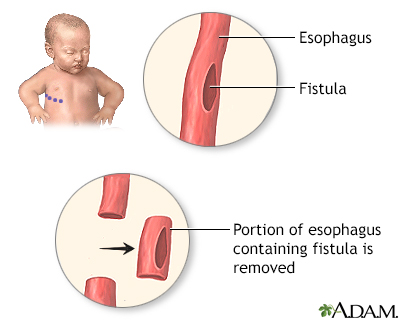
Procedure, part 1
Although the surgical procedure varies depending on the location and type of fistula, in general, an incision is made in the right chest. The section of esophagus that contains the fistula is resected.
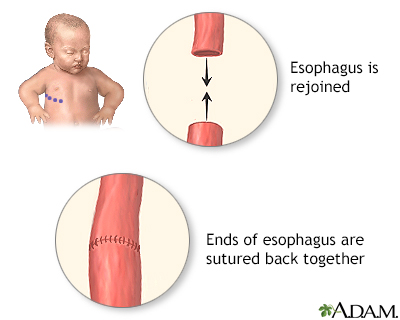
Procedure, part 2
The ends of the esophagus are sutured back together. In many cases, infants are very ill, and therefore require a staged procedure. This involves placing a tube in the stomach (gastrostomy tube), in order to decompress the stomach and prevent fluid in the stomach from flowing up the esophagus, through the fistula and into the lungs. The infant is then cared for in an intensive care unit until he or she is well enough to undergo resection of the fistula and a definitive repair of the esophagus.
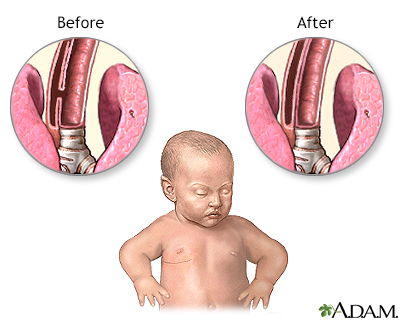
Aftercare
The baby will be cared for pre-operatively and post-operatively in a neonatal intensive care unit. He/she will be placed in an isolette (incubator) to keep warm. He/she may require oxygen and/or mechanical ventilation. A chest tube may be in place to drain fluids. Intravenous fluids and pain medications will be given. Feedings will be started as soon as possible, depending on the extent of the repair. Length of the hospitalization varies, depending on the seriousness of the surgery and the baby's condition.
Related Information
Esophageal atresiaTracheoesophageal fistula and esophageal atresia repair
BACK TO TOP
Review Date: 12/31/2023
Reviewed By: Mary J. Terrell, MD, IBCLC, Neonatologist, Cape Fear Valley Medical Center, Fayetteville, NC. Review provided by VeriMed Healthcare Network. Also reviewed by David C. Dugdale, MD, Medical Director, Brenda Conaway, Editorial Director, and the A.D.A.M. Editorial team.

Health Content Provider
06/01/2025
|
A.D.A.M., Inc. is accredited by URAC, for Health Content Provider (www.urac.org). URAC's accreditation program is an independent audit to verify that A.D.A.M. follows rigorous standards of quality and accountability. A.D.A.M. is among the first to achieve this important distinction for online health information and services. Learn more about A.D.A.M.'s editorial policy, editorial process and privacy policy. A.D.A.M. is also a founding member of Hi-Ethics. This site complied with the HONcode standard for trustworthy health information from 1995 to 2022, after which HON (Health On the Net, a not-for-profit organization that promoted transparent and reliable health information online) was discontinued. |
The information provided herein should not be used during any medical emergency or for the diagnosis or treatment of any medical condition. A licensed medical professional should be consulted for diagnosis and treatment of any and all medical conditions. Links to other sites are provided for information only -- they do not constitute endorsements of those other sites. © 1997- 2025 A.D.A.M., a business unit of Ebix, Inc. Any duplication or distribution of the information contained herein is strictly prohibited.
